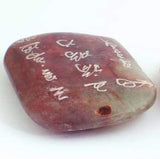JADE BEADS ARE GOOD FOR YOU!
Jade beads are good for the home jewellery maker because they're versatile and jade jewellery sells. Necklace & bracelet buyers love jade!
Buying Jade for Jewellery

Jade is available in all sizes and many shapes. Either as loose beads or temporarily strung into strands. Loose beads are cheaper, but beads on strands will hang better because the holes are more uniform - making them best for necklaces. However, if you plan on knotting your necklace, then loose beads are fine.
How Many Beads Do You Need?
Usually each strand, or string measures 16-inches = 400mm. So if you are buying 6mm beads, you will get (400 divided by 6) about 66 beads to a strand – or around 50 x 8mm beads. A necklace will need at least 75 x 6mm beads, allowing it to hang 9-inchs, 18-inches in all. If you are making a bracelet, you will need about 26 x 8mm beads on average.
Lots Of Colours & Shapes
Most coloured jade is dyed, this is usual, and the colour doesn’t come off. So if you want continuity, purchase all you need for a project in one go. Jade beads are carved into more different shapes than other stone. Like tiny, fish, bottles, rings, flowers, barrels, hearts, tubes, and many other designs to compliment a necklace or bracelet.
History of Jade
For 5,000 years Imperial China used the word “jade” as something precious – as in English we use gold. Because the Chinese believe jade has all the attributes most valued in society:
- A symbol of purity and serenity.
- It’s delicate, but won’t break.
- Is beautiful, but not impermanent.
- It can be flawed with lines, but still pleasing.
Jade is believed to radiate divine unconditional love and balance the emotions. Held in the hand it improves judgment – ancient silk traders held jade while bartering. A small piece of jade worn around the neck was said to dispel illness.

Chinese jade first arrived in the West during the sixteenth century, brought from Canton by the Portuguese. Today, most jade originates from Burma, but carved in China.
The best jade has a waxy, pearly appearance. Feeling cool and so smooth, it seems soft to the touch. Yet hard enough that pressure from a sharp knife will not leave a mark. Every jade carving has a secret meaning.
Benefits Of Jade
Jade was also thought to preserve the body after death and can be found in emperors’ tombs from thousands of years ago. One tomb contained an entire suit made out of jade, to assure the physical immortality of its owner. Jadeite is also thought to cure kidney stones and other kidney ailments.
Types of Jade

The most famous type of jade has shades of green, lavender, yellow, white and grey. These colours form over millions of years from minerals in the rock. However, its the emerald green of jadeite that’s highly sought after. Other colours are influenced by iron (green and brown) and manganese is thought to produces violet. However today, most coloured jade is dyed.
Jade is remarkably tough, used by many early civilizations for axes, knives and weapons. Because of its smooth even texture, jade was soon carved into ornaments – and it wasn’t until 1863 that it was realized that jade was being applied to two different minerals: jadeite and nephrite.
Jadeite is almost never found in individual crystals and is composed of microscopic interlocking crystals that produce a very tough material.
The nephrite variety is composed of fibrous crystals inter-twinned in a tough compact mass. Nephrite is more abundant than jadeite and has fewer color varieties – usually less intense dark spinach greens, white, browns, and black.
Quality of Jade
Although most jade beads these days are dyed, chunks of quality jade is usually sold by the piece rather than per carat.
Although colour is the most important value factor, attention is also paid to translucency, texture, and pattern. Certain patterns, like moss in snow, are expensive. Both jadeite and nephrite are very durable and tough, although jadeite is slightly harder than nephrite.
The top jadeite jade is usually cut into smooth dome shapes called cabochons. Jadeite bangles are also very popular in Asian countries.
Make a Simple Jade Bead Bracelet
To make a bracelet using elastic only take a few minutes, and is a great way to use up leftover beads:
- Arrange the beads to form a 7 inch long bracelet as standard.
- Then take your spool of elastic and string the beads without cutting a length of elastic. This will keep your beads in place.
- To finish, a larger complementary bead for the end looks attractive. Pull both ends of the elastic through this bead, and pull both ends through a small crimp bead. Then flatten the crimp bead with pliers to secure the beads.
To see all our Jade click: Jade Beads




 No Internet?
No Internet?




